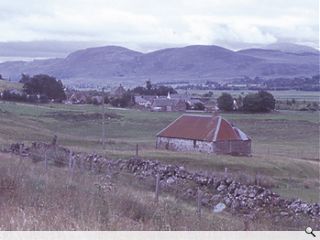The Croft House
11 Feb 2005
by Terry Levinthal
Sunday evenings are great for cheesy BBC productions, and you might recognise this little building from one of the riper ones. It was, in the first series of “Monarch of the Glen”, Katrina’s house, the home of the schoolmistress come social revolutionary with whom the laird’s son had a fancy. Its local name is The Croft House and is one of those unassuming buildings littered about the country, which we dignify by calling vernacular architecture.
Why have I chosen this pleasant, non-descript, unlisted, vacant, unloved, everyday and virtually derelict little house (and by extension, its many cousins up and down the length and breadth of Scotland) as my favourite building? Let’s start at an exhibition at the Museum of Modern Art in New York, in 1964, and its subsequent book entitled Architecture without Architects prepared by (architect) Bernard Rudofsky. He stated, “vernacular architecture does not go through fashion cycles. It is nearly immutable, indeed, unimprovable, since it serves its purpose to perfection.”
Rudofsky wasn’t trying to be anti-architect. The subtitle of the exhibition – “A Short Introduction to Non-Pedigreed Architecture” – offers a more informed purpose of his work, that is, to value the ordinary. He said, “there is much to learn from architecture before it became an expert’s art. The untutored builders in space and time demonstrate an admirable talent for fitting their buildings into the natural surroundings. Instead of trying to ‘conquer’ nature, as we do, they welcome the vagaries of climate and the challenge of topography.”
In today’s world of media-hype and signature structures, vernacular architecture is lost as it doesn’t merit the pedigree necessary for exposure despite the fact it forms part of our everyday experience of the environment.
Buildings like The Croft House demonstrate sustainability in construction and sense of place that is, in most occasions, lacking in modern rural housing, with notable exceptions like the Lotte Glob House. We can see changes to it, notably the crinkly tin roof (now considered part of the rural vernacular), but it hides a roof that would have been thatched with material sourced from the surrounding countryside. The walls are of local stone, rolled down from the nearby hill; the timber comes from the nearby woods and its services locally sourced. In terms of embodied energy, this is the model of sustainability, and its eco-footprint is so small as to be almost unbelievable by today’s standards. It is of its place, and touches lightly upon it.
Another reason why I like this pleasant house is the contribution it could make, with a bit of effort, vision and elbow grease, to the local housing stock. Housing is a big issue. Despite a falling population, we need more houses, primarily to address smaller household sizes (or so we are told). This could provide excellent small household accommodation, and help address these issues. It could also be an excellent holiday home or provide accommodation for tourists (look at Gearannan in the Western Isles for guidance).
However, many would not blink an eye to its demolition, and some would even welcome it. Planning consent would not be required to knock this little jewel down. It will most likely be viewed simply as a site for the next horrid kit-house bungalow to be pushed off the back of a lorry. So much for place, identity and sustainability.
Terry Levinthal is director of the Scottish Civic Trust.
Read next: Can Glasgow’s new “bigger and better” Riverside Museum really be built on a budget of £50million?
Read previous: Relativity in art, space and time, as Manchester’s B of the Bang gets off the starting blocks.
Back to February 2005
Browse Features Archive
Search
News
For more news from the industry visit our News section.
Features & Reports
For more information from the industry visit our Features & Reports section.



